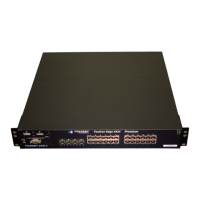Foundry Configuration Guide for the FESX, FSX, and FWSX
16 - 8 © Foundry Networks, Inc. December 2005
IP Interface Redundancy Protocols
You can configure a Foundry Layer 3 Switch to back up an IP interface configured on another Foundry Layer 3
Switch. If the link for the backed up interface becomes unavailable, the other Layer 3 Switch can continue service
for the interface. This feature is especially useful for providing a backup to a network’s default gateway.
Foundry Layer 3 Switches support the following IP interface redundancy protocols:
• Virtual Router Redundancy Protocol (VRRP) – A standard router redundancy protocol based on RFC 2338.
You can use VRRP to configure Foundry Layer 3 Switches and third-party routers to back up IP interfaces on
other Foundry Layer 3 Switches or third-party routers.
• Virtual Router Redundancy Protocol Extended (VRRPE) – A Foundry extension to standard VRRP that adds
additional features and overcomes limitations in standard VRRP. You can use VRRPE only on Foundry Layer
3 Switches.
For configuration information, see the following:
• Virtual Router Redundancy Protocol Extended (VRRPE) – see “Configuring VRRP and VRRPE” on
page 22-1.
• Virtual Router Redundancy Protocol (VRRP) – see “Configuring VRRP and VRRPE” on page 22-1.
Access Control Lists and IP Access Policies
Foundry Layer 3 Switches provide two mechanisms for filtering IP traffic:
• Access Control Lists (ACLs)
• IP access policies
Both methods allow you to filter packets based on Layer 3 and Layer 4 source and destination information.
ACLs also provide great flexibility by providing the input to various other filtering mechanisms such as route maps,
which are used by BGP4.
IP access policies allow you to configure QoS based on sessions (Layer 4 traffic flows).
Only one of these filtering mechanisms can be enabled on a Foundry device at a time. Foundry devices can store
forwarding information for both methods of filtering in the session table.
For configuration information, see the following:
• “Rule-Based IP Access Control Lists (ACLs)” on page 12-1
• “Policies and Filters” on page C-1
Basic IP Parameters and Defaults – Layer 3 Switches
IP is enabled by default. The following IP-based protocols are all disabled by default:
• Routing protocols
• Routing Information Protocol (RIP) – see “Configuring RIP” on page 17-1
• Open Shortest Path First (OSPF) – see “Configuring OSPF” on page 20-1
• Border Gateway Protocol version 4 (BGP4) – see “Configuring BGP4” on page 21-1
• Multicast protocols
• Internet Group Membership Protocol (IGMP) – see “Changing Global IP Multicast Parameters” on
page 19-3
• Protocol Independent Multicast Dense (PIM-DM) – see “PIM Dense” on page 19-6
• Protocol Independent Multicast Sparse (PIM-SM) – see “PIM Sparse” on page 19-13
• Distance Vector Multicast Routing Protocol (DVMRP) – see “DVMRP Overview” on page 19-52

